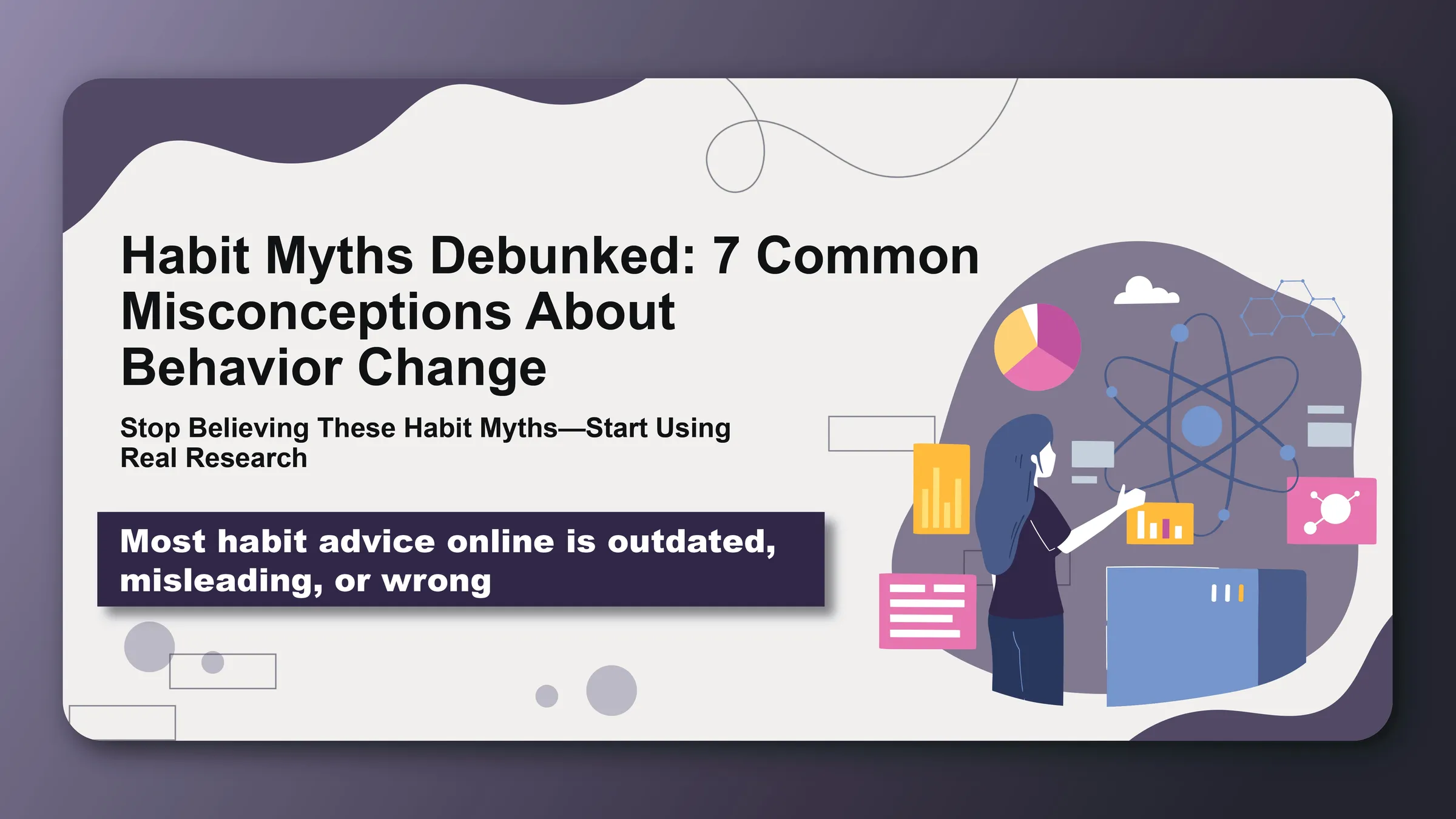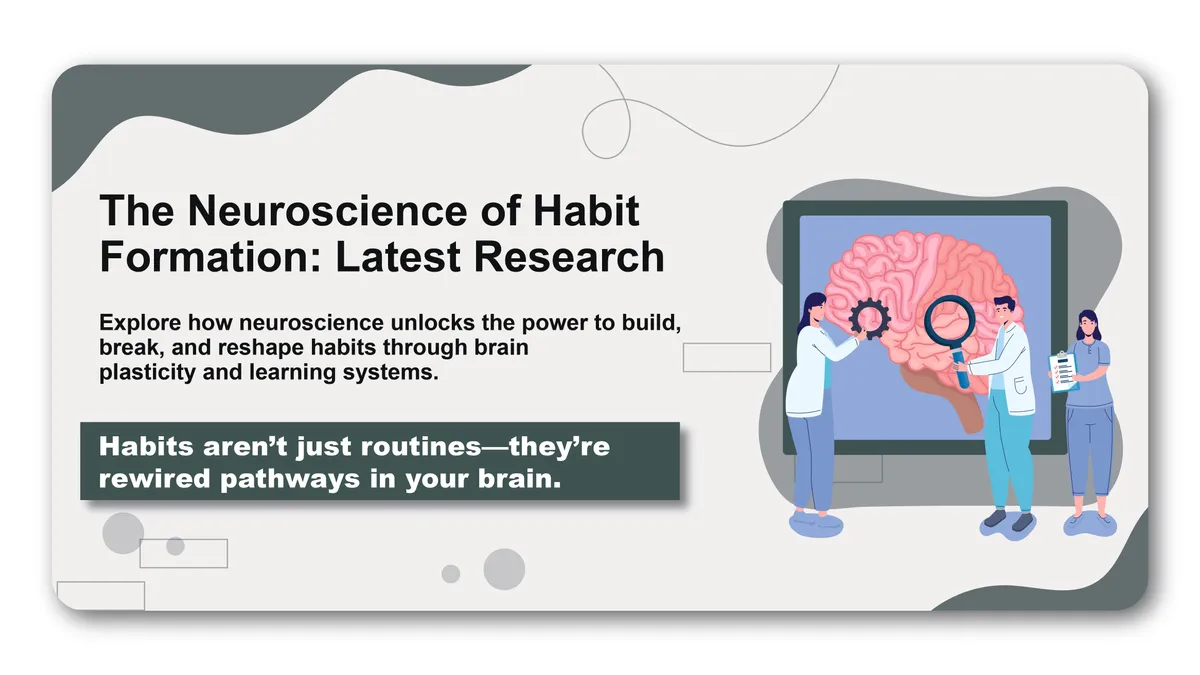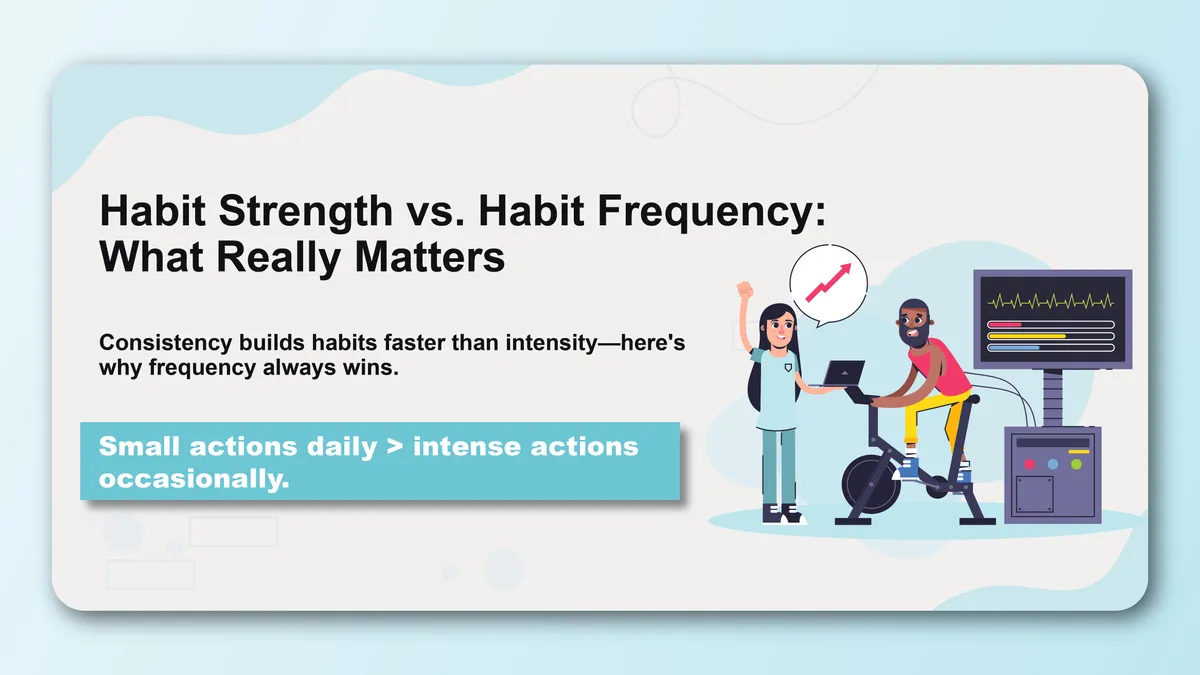The internet is full of habit advice, but much of it is based on outdated research, cultural myths, or well-intentioned but incorrect assumptions. These misconceptions can sabotage your efforts to build lasting habits and lead to unnecessary frustration and failure.
It's time to separate fact from fiction. Let's debunk the most common myths about habit formation and reveal what science actually tells us about building lasting change.
Myth #1: "It Takes 21 Days to Form a Habit"
The Myth
This is probably the most persistent myth in habit formation. The idea that any habit can be formed in exactly 21 days has been repeated so often that it's accepted as scientific fact.
The Reality
The 21-day rule is completely false. This myth originated from a misinterpretation of Dr. Maxwell Maltz's 1960 book "Psycho-Cybernetics." Dr. Maltz observed that it took patients at least 21 days to adjust to changes like plastic surgery, but this was about psychological adjustment, not habit formation.
What Science Actually Says
Real Timeline: Dr. Phillippa Lally's 2009 study at University College London found that it takes an average of 66 days for a behavior to become automatic, with a range of 18 to 254 days depending on the habit complexity and individual factors.
Factors That Affect Timeline:
- Habit complexity: Simple habits (drinking water) form faster than complex ones (exercise routines)
- Individual differences: Some people naturally form habits faster
- Consistency: Daily practice accelerates habit formation
- Context stability: Consistent environments support faster habit formation
The Takeaway
Stop expecting miracles at 21 days. Give yourself at least 2-3 months to establish a new habit, and be patient with the process.
Myth #2: "Willpower Is the Key to Building Habits"
The Myth
If you just have enough willpower and motivation, you can build any habit. People who fail to maintain habits simply lack self-control.
The Reality
Willpower is not only unreliable—it's completely unnecessary for habit formation. Research shows that willpower is a limited resource that depletes throughout the day. More importantly, successful habit formation actually reduces the need for willpower over time.
What Science Actually Says
Willpower Research: Studies by Dr. Roy Baumeister demonstrate that willpower functions like a muscle—it gets tired with use and needs rest to recover. This is called "decision fatigue."
Habit Automaticity: As habits become automatic, they require less conscious control and willpower. The goal of habit formation is to make behaviors so routine that they happen without thinking.
Environmental Design: Research by Dr. Wendy Wood shows that environmental cues are far more powerful than willpower in maintaining behaviors.
The Takeaway
Instead of relying on willpower, focus on:
- Environmental design: Make good habits easy and bad habits hard
- Habit stacking: Link new habits to existing routines
- Starting small: Begin with micro-habits that require minimal willpower
- Consistent timing: Same time, same place reduces decision fatigue
Myth #3: "You Need to Be Motivated to Start Habits"
The Myth
You should wait until you feel motivated to start a new habit. Motivation is necessary to maintain habits long-term.
The Reality
Motivation is temporary and unreliable. Waiting for motivation is like waiting for the perfect moment—it rarely comes. Successful habit builders don't rely on motivation; they rely on systems.
What Science Actually Says
Motivation vs. Action: Research shows that action often precedes motivation, not the other way around. The act of doing something can create motivation, not vice versa.
Habit Formation Process: Dr. Ann Graybiel's research at MIT shows that habits become automatic through repetition, not motivation. Once established, habits can persist even when motivation is low.
Emotional Regulation: Studies indicate that consistent behavior helps regulate emotions and energy levels, making motivation more stable over time.
The Takeaway
- Start before you feel ready: Begin with tiny actions that require minimal motivation
- Focus on systems: Build reliable processes that work regardless of how you feel
- Expect motivation to fluctuate: Plan for days when motivation is low
- Action creates motivation: Do the behavior first, and motivation often follows
Myth #4: "Habits Should Feel Easy Immediately"
The Myth
If a habit feels difficult or uncomfortable, you're doing it wrong. Good habits should feel natural and effortless from the start.
The Reality
New habits are supposed to feel difficult at first. Your brain is literally rewiring itself, which requires energy and creates resistance. Discomfort is normal and expected.
What Science Actually Says
Neuroplasticity: Brain imaging studies show that learning new behaviors creates new neural pathways, which initially require more energy than established pathways.
Habit Formation Curve: Research indicates that habits follow a predictable pattern: high effort initially, followed by decreasing effort as automaticity develops.
Comfort Zone: Psychological research shows that growth happens outside your comfort zone. If something feels completely easy, you're probably not challenging yourself enough.
The Takeaway
- Expect initial resistance: Discomfort is a sign that you're building new neural pathways
- Start small enough: Make habits challenging but manageable
- Focus on consistency: Regular practice will make behaviors feel easier over time
- Celebrate small wins: Acknowledge effort, not just ease
Myth #5: "Missing One Day Ruins Everything"
The Myth
If you miss a day of your habit, you've broken the chain and need to start over. Consistency means never missing a single day.
The Reality
Perfectionism is the enemy of habit formation. Missing one day doesn't erase your progress or reset your habit formation timeline. In fact, expecting perfection often leads to giving up entirely.
What Science Actually Says
Habit Strength: Research shows that habits exist on a spectrum of strength. Missing one day doesn't significantly impact overall habit strength if you get back on track quickly.
All-or-Nothing Thinking: Psychological studies demonstrate that perfectionist thinking is associated with higher rates of habit abandonment.
Recovery Patterns: Studies indicate that people who bounce back quickly from setbacks are more successful at long-term habit maintenance.
The Takeaway
- Never miss twice: One missed day is a mistake; two missed days starts a pattern
- Plan for imperfection: Expect occasional misses and have a recovery plan
- Focus on overall consistency: Aim for 80-90% consistency rather than 100%
- Use the minimum viable habit: Have a tiny version for difficult days
Myth #6: "Habits Are Only About Repetition"
The Myth
If you just repeat a behavior enough times, it will automatically become a habit. Frequency is the only factor that matters.
The Reality
Habit formation is much more complex than simple repetition. While repetition is important, context, rewards, and environmental factors play crucial roles.
What Science Actually Says
Habit Loop: MIT research shows that habits require three elements: cue, routine, and reward. Repetition alone isn't enough.
Contextual Learning: Studies demonstrate that habits are closely tied to environmental contexts. Same behavior in different contexts may not transfer.
Reward Systems: Neuroscience research shows that the brain's reward system must be activated for habits to form. Repetition without reward doesn't create lasting habits.
The Takeaway
- Design complete habit loops: Include clear cues, routines, and rewards
- Maintain consistent contexts: Same time, same place strengthens habit formation
- Include immediate rewards: Give yourself positive reinforcement for completing habits
- Focus on environmental design: Shape your surroundings to support habit formation
Myth #7: "Bad Habits Can Be Eliminated"
The Myth
You can simply stop bad habits through willpower and determination. Just don't do the behavior anymore.
The Reality
You can't eliminate bad habits—you can only replace them. The neural pathways for bad habits remain in your brain. Instead of elimination, focus on substitution.
What Science Actually Says
The Golden Rule of Habit Change: Dr. Charles Duhigg's research shows that the most effective way to change habits is to keep the same cue and reward but change the routine.
Neural Persistence: Brain imaging studies show that even after changing behaviors, the old neural pathways remain and can be reactivated under stress or specific conditions.
Replacement Strategy: Studies indicate that successful habit change involves replacing bad habits with better ones, not eliminating them entirely.
The Takeaway
- Identify the cue and reward: Understand what triggers your bad habit and what reward it provides
- Find a replacement routine: Choose a healthier behavior that provides the same reward
- Maintain the same structure: Keep the same cue and reward, change only the routine
- Expect relapses: Old habits can resurface under stress; have a plan for getting back on track
The Truth About Habit Formation
What Really Works
1. Start Ridiculously Small
- Begin with micro-habits that are impossible to fail
- Focus on consistency over intensity
- Gradually increase difficulty as habits become automatic
2. Design Your Environment
- Make good habits obvious and easy
- Make bad habits invisible and difficult
- Use environmental cues to trigger desired behaviors
3. Focus on Identity
- Connect habits to who you want to become
- Act in alignment with your desired identity
- Celebrate progress as evidence of identity change
4. Be Patient and Persistent
- Expect habit formation to take 2-3 months
- Plan for setbacks and have recovery strategies
- Focus on long-term consistency over short-term perfection
Common Factors in Successful Habit Formation
Environmental Design: Creating surroundings that support desired behaviors Social Support: Having people who encourage and model good habits Tracking Systems: Monitoring progress and celebrating wins Flexibility: Adapting habits to changing circumstances Self-Compassion: Being kind to yourself during setbacks
Red Flags: When Habit Advice Is Probably Wrong
Beware of advice that claims:
- Any habit can be formed in exactly X days
- Willpower is all you need
- You must be motivated to start
- Perfect consistency is required
- One method works for everyone
- Habits should feel easy immediately
- Bad habits can be eliminated completely
Look for advice that emphasizes:
- Individual differences in habit formation
- Systems and environmental design
- Patience and long-term thinking
- Recovery strategies for setbacks
- Scientific evidence and research
- Realistic timelines and expectations
Your Myth-Free Habit Strategy
Step 1: Reality Check
- Accept that habits take 2-3 months to form
- Expect initial difficulty and resistance
- Plan for occasional setbacks
- Focus on systems, not motivation
Step 2: Evidence-Based Approach
- Start smaller than you think necessary
- Design your environment for success
- Create complete habit loops (cue, routine, reward)
- Replace bad habits instead of eliminating them
Step 3: Long-Term Perspective
- Measure consistency, not perfection
- Celebrate small wins and progress
- Adjust strategies based on what works
- Be patient with the process
Step 4: Continuous Learning
- Stay informed about habit research
- Experiment with different strategies
- Learn from both successes and failures
- Share knowledge with others
The Bottom Line
Habit formation is a science, not a collection of motivational platitudes. By understanding what really works—and what doesn't—you can build lasting habits that stick.
Remember: there's no magic number of days, no perfect formula, and no one-size-fits-all solution. What matters is understanding the principles of habit formation and applying them consistently over time.
Stop believing the myths and start building habits based on evidence. Your future self will thank you.
Ready to build habits based on science, not myths? Start your evidence-based habit journey with Habityzer and discover what really works for lasting behavior change.



